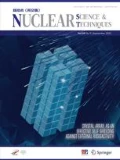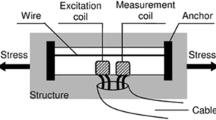Abstract
To study vertical sag requirements and factors affecting the stretched wire alignment method, the vertical sag equation is first derived theoretically. Subsequently, the influencing factors (such as the hanging weight or tension, span length, temperature change, elastic deformation, and the Earth’s rotation) of the vertical sag are summarized, and their validity is verified through actual measurements. Finally, the essential factors affecting vertical sag, i.e., the specific strength and length, are discussed. It is believed that the vertical sag of a stretched wire is proportional to the square of the length and inversely proportional to the specific strength of the material.






Similar content being viewed by others
References
X.K. Ambayev, Precision Baseline Survey (Surveying and Mapping Publishing House, Beijing, 1981), pp. 140–146. (in Chinese)
J.D. Yuan, Summary of application of stretched wire technology in accelerator alignment and survey. High Power Laser and Particle Beams 32, 045102 (2020). https://doi.org/10.11884/HPLPB202032.190259 (in Chinese)
J.D. Yuan, Y. He, B. Zhang et al., Alignment of beam position monitors in cryomodule of CADS-Injector II. Nucl. Sci. Tech. 28, 75 (2017). https://doi.org/10.1007/s41365-017-0232-9
Q. Ren, Dam Deformation Observation (Hohai University Press, Nanjing, 1989). (in Chinese)
N.F. Zhao, Y.F. Zhao, T.G. Ou et al., Development of a new type of optical-mechanical stretched wire instrument. J. Geodesy Geodyn. 34(2), 180–182 (2014). https://doi.org/10.14075/j.jgg.2014.01.040
G. Galileo, Two New Sciences, Including Centers of Gravity and Forces of Percussion, Translated, with Introduction and Notes, by Stillman Drake (The University of Wisconsin Press, Madison, 1974).
H.H. Goldstine, A History of the Calculus of Variations from the 17th Through the 19th Century (Springer-Verlag, New York, 1980).
F. Behroozi, P. Mohazzabi, J.P. McCrickard, Remarkable shapes of a catenary under the effect of gravity and surface tension. Am. J. Phys. 62, 1121 (1994). https://doi.org/10.1119/1.17672
X.L. Wang, L. Dong, L. Wu, Analysis and experimental concepts of the vibrating wire alignment technique. Chin. Phys. C. 38(11), 117010 (2014). https://doi.org/10.1088/1674-1137/38/11/117010
C. Zhang, C. Mitsuda, K. Kajimoto. Eigenfrequency Wire Alignment System for Magnet Fiducialization, in Proceedings of the 14th International Workshops on Accelerator Alignment. ESRF, Grenoble, France, 2016. https://inspirehep.net/literature/1722630
W. Wang, Z. Tang, X.Y. He et al., Design and construction of a multi-sensor position monitoring system applied to key components of synchrotron sources. Nucl. Sci. Tech. 27, 134 (2016). https://doi.org/10.1007/s41365-016-0132-4
J.F. Stanton, M.O. Eberhard, P.J. Barr, A weighted-stretched-wire system for monitoring deflections. Eng. Struct. 25, 347–357 (2003). https://doi.org/10.1016/S0141-0296(02)00163-3
A. Temnykh, Y. Levashov, Z. Wolf, A study of undulator magnets characterization using the vibrating wire technique. Nuclear Instrum. Methods Phys. Res. A 622, 650–656 (2010). https://doi.org/10.1016/j.nima.2010.06.362
S. Sudoua, N. Khalatyanb, Y. Kuriharab et al., Measurements and calculations of gravitational and electrostatic wire sags for a 4.6 meter long drift chamber. Nucl. Instrum. Methods A. 383, 391–398 (1996). https://doi.org/10.1016/S0168-9002(96)00818-2
Z.L. Lan, X.F. Yang, W.M. Chen et al., Study on non-contact weighted-stretched-wire system for measuring bridge deflections and its effect factors. Eng. Struct. 30, 2413–2419 (2008). https://doi.org/10.1016/j.engstruct.2008.01.021
K. Wang, Z.Y. Yang, S.Q. Liao et al., Analysis of the influence of metal wire sagging in the pulse tight wire magnetic axis measurement method. Nuclear Techniques 38, 080201 (2015). https://doi.org/10.11889/j.0253-3219.2015.hjs.38.080201 (in Chinese)
Q. Fu, K. Zhu, Y.R. Lu et al., Detailed study of RF properties of cold models for CW windowtype RFQ. Nucl. Sci. Tech. 29(11), 157 (2018). https://doi.org/10.1007/s41365-018-0489-7
H. Du, Y.J. Yuan, Z.S. Li et al., Beam dynamics, RF measurement, and commissioning of a CW heavy ion IH-DTL. Nucl. Sci. Tech. 29(3), 42 (2018). https://doi.org/10.1007/s41365-018-0373-5
L. Chen, S.H. Zhang, Y.M. Li et al., Room-temperature test system for 162.5 MHz high power couplers. Nucl. Sci. Tech. 30(1), 7 (2019). https://doi.org/10.1007/s41365-018-0531-9
L.P. Sun, Z.Y. Yuan, C. Zhang et al., New thermal optimization scheme of power module in solid-state amplifier. Nucl. Sci. Tech. 30(4), 68 (2019). https://doi.org/10.1007/s41365-019-0585-3
H.H. Goldstine, A History of the Calculus of Variations (Springer-Verlag, New York, 1980).
J.D. Yuan, B. Zhang, Y.Q. Wan et al., Deformation mechanism of the Cryostat in the CADS Injector II. Cryogenics 89, 113–118 (2018). https://doi.org/10.1016/j.cryogenics.2017.11.010
Q. Chen, Z. Gao, Z.L. Zhu et al., Multi-frequency point supported LLRF front-end for CiADS wide-bandwidth application. Nucl. Sci. Tech. 31(3), 29 (2020). https://doi.org/10.1007/s41365-020-0733-9
A. Mareno, L.Q. English, The stability of the catenary shapes for a hanging cable of unspecified length. Eur. J. Phys. 30, 97–108 (2009). https://doi.org/10.1088/0143-0807/30/1/010
G.R. Dean, Precise measurements with a steel tape or wire. Am. Math. Mon. 5, 20 (1913)
X.C. Lu, G.J. Liu, X.S. Li, Analysis of floating wire system. Hydropower Autom. Dam Monit. 34(2), 38–41 (2010). (in Chinese)
Z.Z. Li, G.J. Liu, Analysis of the system error of the tension line horizontal displacement meter. Hydropower Autom. Dam Monit. 33, 62–64 (2009). https://doi.org/10.3969/j.issn.1671-3893.2009.06.015 (in Chinese)
Y.Z. Gong, W.X. Wang, Research on two-dimensional tension wire and its precision. J. Wuhan Univ Water Conserv. Electr. Power. 29(2), 69–74 (1996). (in Chinese)
Z.C. Wang, Analysis of related issues in the design of bidirectional stretched wire. Dam Saf. 30(2), 33–39 (1994). (in Chinese)
W.B. Zhu, Y.W. Zhou, Research on the technology of ultra-long stretched wire without float. Hydropower Energy Sci. 25(1), 75–78 (2007). https://doi.org/10.3969/j.issn.1000-7709.2007.01.021 (in Chinese)
T.Z. Tang, Z.C. Li, W.B. Zhao, Analysis of super long tension wire and its precision influence. Water Conserv. Hydropower Technol. 34(7), 79–81 (2003). https://doi.org/10.3969/j.issn.1000-0860.2003.07.027 (in Chinese)
J.B. Zhou, Y.J. Wang, Y.Q. Gong, Development and technical characteristics of non-floating stretched wire. Dam Saf. 5, 28–31 (2016). https://doi.org/10.3969/j.issn.1671-1092.2016.05.008 (in Chinese)
G.J. Liu, Z.Z. Li, X.S. Li, Test analysis of horizontal displacement monitoring device for long pipeline stretched wire. Hydropower Autom. Dam Monit. 36, 53–56 (2012). https://doi.org/10.3969/j.issn.1671-3893.2012.04.016 (in Chinese)
L.Z. Fang, Improvement of the stretched method of building deformation observation. Water Conserv. Hydropower Technol. 45(10), 53–55 (1984). (in Chinese)
Z.R. Ye, W.X. Wang, Y.Z. Gong, Catenary two-dimensional tension wire and three-dimensional inverted hammer wire telemetry system. Dam Obs. Geotech. Test. Z1, 40–45 (1991). (in Chinese)
J.D. Yuan, The alignment technology of ADS-cry module in low temperature. Chin. J. Low-Temp. Phys. 37(2), 161–164 (2015). https://doi.org/10.13380/j.cnki.chin.j.lowtemp.phys.2015.02.015 (in Chinese)
R.W. Warren, Limitations on the use of the pulsed-wire field measuring technique. Nuclear Instrum. Methods Phys. Res. A. 272, 257–263 (1988). https://doi.org/10.1016/0168-9002(88)90233-1
J.G. Lu, J.H. Zhao, Research and application of 500 m unfloating stretched wire. East China Power. 38(8), 1181–1184 (2010). (in Chinese)
A. Temnykh, Vibrating wire field-measuring technique. Nuclear Instrum. Methods Phys. Res. A 399, 185–194 (1997). https://doi.org/10.1016/S0168-9002(97)00972-8
Irvine, H.M., Cable Structures (Dover Publications, New York 1992), pp. 16–20.
Z.Z. Dai, Qualitative analysis of the movement of the tension line caused by universal gravitation. Sichuan Surv. Mapp. 3, 36–38 (1996) (in Chinese)
F. Becker, Définition d’un réseau de référence métrologique pourle positionnement d’un grand accélérateur linéaire. Dissertation, INSA Strasbourg, 4 December 2003. (in French)
Author information
Authors and Affiliations
Contributions
All authors contributed to the study conception and design. Material preparation, data collection and analysis were performed by Jian-Dong Yuan. The first draft of the manuscript was written by Jian-Dong Yuan and all authors commented on previous versions of the manuscript. All authors read and approved the final manuscript.
Corresponding author
Additional information
This work was supported by Large Research Infrastructures “China initiative Accelerator Driven System” (No. 2017-000052-75-01-000590).
Rights and permissions
About this article
Cite this article
Yuan, JD., Wu, JX., Zhang, B. et al. Investigation of factors affecting vertical sag of stretched wire. NUCL SCI TECH 32, 20 (2021). https://doi.org/10.1007/s41365-021-00847-5
Received:
Revised:
Accepted:
Published:
DOI: https://doi.org/10.1007/s41365-021-00847-5




